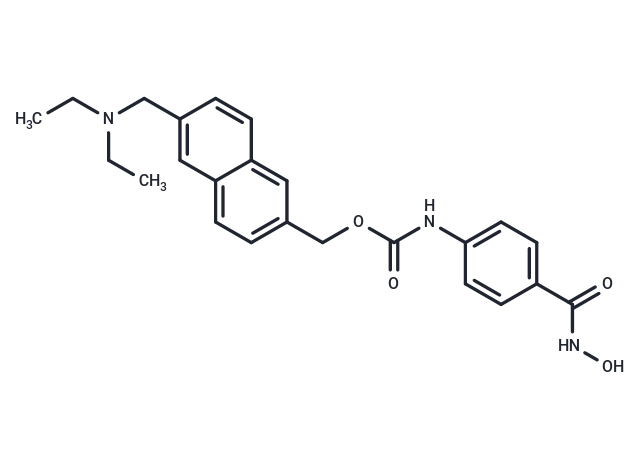Shopping Cart
- Remove All
 Your shopping cart is currently empty
Your shopping cart is currently empty

Givinostat (ITF-2357) is an HDAC inhibitor with IC50 values of 198 nM for HDAC1 and 157 nM for HDAC3.


| Description | Givinostat (ITF-2357) is an HDAC inhibitor with IC50 values of 198 nM for HDAC1 and 157 nM for HDAC3. |
| Targets&IC50 | HDAC4 (human):1059 nM (IC50), HD1-A:16 nM (IC50), HDAC9 (human):541 nM (IC50), HD2:10 nM (IC50), HDAC3 (human):157 nM (IC50), HDAC6 (human):315 nM (IC50), HD1-B:7.5 nM (IC50), HDAC10 (human):340 nM (IC50), HDAC8 (human):854 nM (IC50), HDAC11 (human):292 nM (IC50), HDAC2 (human):325 nM (IC50), HDAC7 (human):524 nM (IC50), HDAC5 (human):532 nM (IC50), HDAC1 (human):198 nM (IC50) |
| In vitro | Givinostat (ITF2357) effectively suppresses IL-1β production induced by LPS, achieving a greater than 70% reduction in IL-1β secretion at concentrations of 25, 50, and 100 nM, outperforming ITF3056. It also inhibits IL-6 production in PBMCs triggered by TLR agonists and the combination of IL-12 plus IL-18, with a 50% decrease in IL-6 secretion at 50 nM, although no further reduction is observed at higher concentrations of 100 and 200 nM. Additionally, Givinostat significantly inhibits JS-1 cell proliferation in a concentration-dependent manner, with concentrations ≥500 nM showing substantial inhibition (P<0.01). Notably, cells co-treated with Givinostat ≥250 nM plus LPS exhibit a significantly higher inhibition rate compared to those treated without LPS at the same Givinostat concentration (P<0.05). |
| In vivo | Givinostat (ITF2357), used as a positive control at a dose of 10 mg/kg, effectively decreased serum TNFα levels by 60%. Notably, pretreatment with ITF3056, starting at a dosage of 0.1 mg/kg, significantly lowered circulating TNFα levels by up to 90%. To induce a substantial raise in serum IL-1β production, an elevated LPS dose (10 mg/kg) is administered, followed by blood collection after 4 hours. Furthermore, lower doses of Givinostat (ITF-2357) at 1 or 5 mg/kg resulted in a 22% and a 40% reduction in TNFα levels, respectively. |
| Cell Research | After the JS-1 cell line is cultured in DMEM with 10% fetal bovine serum for 24 h, 30 wells of JS-1 cells are divided into two groups. In the first group, the culture medium is replaced by complete medium with final Givinostat (ITF-2357) concentrations of 0 nM, 125 nM, 250 nM, 500 nM, and 1000 nM. In the second group, Givinostat of relevant concentrations is added concomitantly with 100 nM of LPS solution. Three replicates are performed for each group. After inoculation at 37°C and 5% CO2 for 24 h, each well (100 μL) is incubated with 10 μL of CCK-8 solution. The plates are incubated at 37°C for 1 h and the absorbance is measured at 450 nm using a microplate reader[2]. |
| Molecular Weight | 421.497 |
| Formula | C24H27N3O4 |
| Cas No. | 497833-27-9 |
| Storage | Powder: -20°C for 3 years | In solvent: -80°C for 1 year | Shipping with blue ice. |
| Solubility Information | DMSO: Soluble |

Copyright © 2015-2025 TargetMol Chemicals Inc. All Rights Reserved.